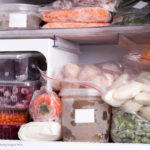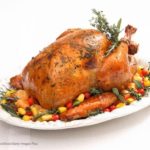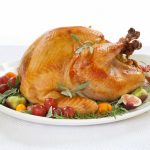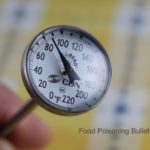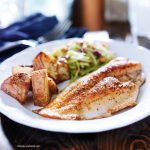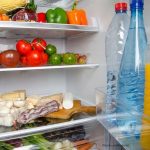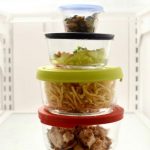It's now four days after Thanksgiving, and that means that all leftovers from that holiday dinner must be discarded or frozen today, according to the USDA. Of course, this is assuming that you refrigerated that food promptly - within two hours of it coming out of the fridge or oven. Between the temperature range of 40°F to 140°F, bacteria numbers can double in foods every 20 minutes. And those pathogens can make toxins that aren't destroyed by heat. So even if you thoroughly reheat leftovers to 165°F, as you should every time, you may still get sick. That's why we stress prompt refrigeration of perishable foods, including meats, egg dishes, seafood, poultry, casseroles, and cooked vegetables. To freeze foods, store them in freezer bags or other containers in relatively small … [Read more...]
Keep Thanksgiving Leftovers Safe With Tips From the USDA
It's Thanksgiving. One of the best parts of this holiday is leftovers. So you should know how to keep Thanksgiving leftovers safe with these tips from the USDA. When you take foods out of the oven or refrigerator, set a timer and follow the two hour rule. That means that all perishable items such as the turkey, stuffing, side dishes, and desserts should be refrigerated within two hours after coming out of those appliances. After two hours, these foods enter the "danger zone" between 40°F and 140°F, where bacteria can double every 20 minutes. Then, even if you thoroughly reheat those foods, the bacteria could have produced toxins that are not destroyed by heat and can still make you sick. When you break down the foods from the meal, put them into shallow containers so they cool … [Read more...]
Prepare Your Holiday Turkey Safely with Tips From the CDC
It's almost Thanksgiving! Prepare your holiday turkey safely with tips from the Centers for Disease Control and Prevention (CDC). Since turkey can be contaminated with Salmonella bacteria, it must be handled carefully. First of all, store the turkey properly. It should be stored in the freezer until you are ready to thaw it. Do not store a turkey in a car trunk, in snow, or on the back porch. At this point it's too late to properly thaw a large frozen turkey in the fridge, but you can cook it from the frozen state. It takes 24 hours of thawing in the refrigerator for each four to five pounds of turkey. Never ever thaw a turkey or any meat on the counter. The meat will remain in the danger zone of 40°F to 140°F too long, and bacteria will multiply. At room temperature, bacterial … [Read more...]
Ten USDA Tips To Keep Restaurant Leftovers Safe at Home
The USDA is offering ten tips to keep restaurant leftovers safe when you take them home. Now that the COVID-19 pandemic is easing, more people are going out to eat. But how you handle doggie bags can have an impact on your health. Firsts of all, if you are having dinner before going to a movie or shopping, do not take leftovers. Perishable food needs to be refrigerated within two hours after it comes out of the oven or fridge. Since it probably took you about an hour to eat, you don't have much time to refrigerate the food. Second, bring the food directly home. The faster you get it into the fridge, the lower the chance that bacteria will grow. Third, you can refrigerate meat and poultry leftovers at 40°F or below for four days. Eggs and lunch meats can be stored in the fridge … [Read more...]
Keep Thanksgiving Leftovers Safe With Tips From the USDA
Happy Thanksgiving! Keep Thanksgiving leftovers safe with tips from the USDA. Since the meal for this holiday is usually quite large, you will most likely have lots of leftovers, which must be stored properly to prevent food poisoning. The temperature danger zone for perishable foods is 40°F to 140°F. In that range, bacteria in foods can double every 20 minutes. First, remember the two hour rule. All perishable foods must be refrigerated within two hours of coming out of the oven or out of the fridge for serving. This time decreases to one hour if the ambient air temperature is above 90°F. To make sure that food cools down quickly and gets through the danger zone fast, divide food into smaller amounts and package in shallow containers. When you have stored the food in the … [Read more...]
Do You Know How to Safely Store and Reheat Leftovers?
Now that fall is here and people are making more substantial food in larger quantities, it's time to think about the safe handling of food. Do you know how to safely store and reheat leftovers? Many cases of food poisoning may occur because leftovers are improperly handled. The first thing to know is that all leftover perishable foods should be refrigerated as early as possible after the food has finished cooking. The danger zone is between 40°F and 140°F. In that temperature range, bacteria can double every 20 minutes. So it's important to divide food into smaller quantities and put into shallow containers. Cut large pieces of meat into smaller pieces. Divide a big pot of soup into smaller containers. Cover and refrigerate within 2 hours. Then make sure that your refrigerator is … [Read more...]
Thanksgiving Leftovers: How to Handle Them so You Don’t Get Sick
The USDA is offering tips on how to handle Thanksgiving leftovers so you and your family don't get sick. It is now four days after Thanksgiving, which means that today is the day all of the leftover food from that holiday should be either eaten or frozen for food safety reasons. First, remember to keep food out of the danger zone of 40°F to 140°F. That's the temperature range where bacteria grow most rapidly. All of your Thanksgiving food should have been refrigerated within two hours of finishing cooking or being taken out of the fridge. All of the food should be cooled quickly. Never put the whole turkey back into the fridge, since it can take a long to cool to a safe temperature. Cut the turkey into pieces, slice the breast, and place the meat into shallow … [Read more...]
The Food Safety of Storing Holiday Leftovers
Food temperature plays a key role in preparing, serving and storing food safely. To store holiday leftovers safely, follow these tips from the the U.S. Food and Drug Administration (FDA). Why is this important? The number of bacteria on food sitting at room temperature can double in 20 minutes. Food poisoning from these bacteria can cause serious, sometimes life-threatening illness. Food that has been left at room temperature for more than two hours is not safe to eat. The first step: buy some thermometers. It's impossible to know if your food is being cooked to a safe temperature or stored at a safe temperature without them. You can buy food thermometers and thermometers for your refrigerator and freezer at grocery stores, hardware stores and discount retailers. Refrigerated food … [Read more...]
CSPI Publishes Consumer Guide to Safer Food
The Center for Science in the Public Interest (CSPI) has published a consumer guide to safer food called From Supermarket to Leftovers. The booklet is available from NutritionAction.com. Every year, 48,000,000 Americans get sick from contaminated food. Three thousand Americans die from foodborne illness every year. Since contaminated food is getting into our homes, even though farmers and food processors are responsible for selling food that doesn't make us sick, it's up to the consumer to be the last line of defense. Sarah Klein, senior food safety attorney for CSPI wrote the booklet and calls her strategy "defensive eating". Some of the information in the book includes advice about the last item you should put in your grocery cart (seafood), what produce to seek out (local or … [Read more...]
Store and Use Leftover Food Safely
Michigan State University Extension is offering tips for storing and using leftover food safely. If not handled properly, leftover food can become a vehicle for food poisoning. Always wash hands with soap and water before handling cooked food, especially food you are going to store to eat later. Always use clean utensils to handle this food. Store it in clean containers. Don't put the food back into the same container it was in before cooking, unless it has been thoroughly washed with soap and water. And sanitize cutting boards and counters. Leftovers should be stored in small, shallow containers, less than three inches in height. Always cover leftover containers. Don't stack containers, but leave some air space around them so the cold air can circulate. Don't use large, deep … [Read more...]
